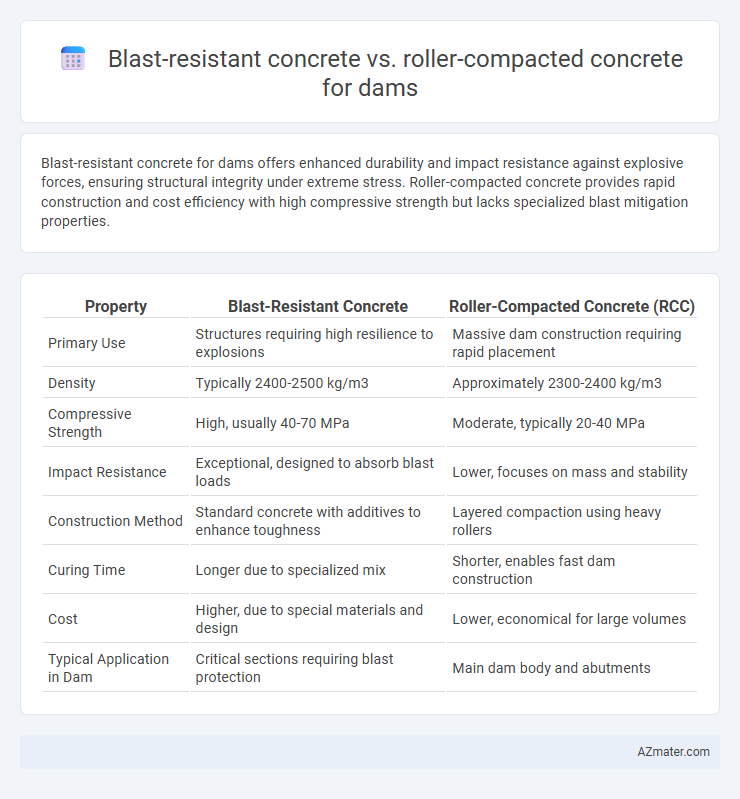Blast-resistant concrete for dams offers enhanced durability and impact resistance against explosive forces, ensuring structural integrity under extreme stress. Roller-compacted concrete provides rapid construction and cost efficiency with high compressive strength but lacks specialized blast mitigation properties.
Table of Comparison
| Property | Blast-Resistant Concrete | Roller-Compacted Concrete (RCC) |
|---|---|---|
| Primary Use | Structures requiring high resilience to explosions | Massive dam construction requiring rapid placement |
| Density | Typically 2400-2500 kg/m3 | Approximately 2300-2400 kg/m3 |
| Compressive Strength | High, usually 40-70 MPa | Moderate, typically 20-40 MPa |
| Impact Resistance | Exceptional, designed to absorb blast loads | Lower, focuses on mass and stability |
| Construction Method | Standard concrete with additives to enhance toughness | Layered compaction using heavy rollers |
| Curing Time | Longer due to specialized mix | Shorter, enables fast dam construction |
| Cost | Higher, due to special materials and design | Lower, economical for large volumes |
| Typical Application in Dam | Critical sections requiring blast protection | Main dam body and abutments |
Introduction to Dam Construction Materials
Blast-resistant concrete features enhanced toughness and energy absorption, making it ideal for dams requiring high impact resistance against explosive forces and debris. Roller-compacted concrete offers rapid placement and high density, providing excellent durability and cost efficiency in large-scale dam construction projects. Selecting the appropriate material balances structural integrity, construction speed, and environmental resilience critical for dam safety and longevity.
Overview of Blast-resistant Concrete
Blast-resistant concrete is engineered with enhanced toughness and energy absorption capabilities to withstand high-intensity explosive forces typically encountered in dam infrastructure. It incorporates specialized aggregates, fibers, and admixtures to improve its tensile strength and reduce spalling under blast loading conditions. This concrete type is crucial for maintaining structural integrity and safety in critical dam applications exposed to potential blast hazards.
Overview of Roller-compacted Concrete
Roller-compacted concrete (RCC) is a specialized concrete mix characterized by low water content and high density, designed for rapid placement using earth-moving equipment, making it ideal for dam construction. RCC offers enhanced durability, excellent shear strength, and cost-effectiveness compared to traditional concrete types, including blast-resistant concrete. Its unique composition allows for faster construction timelines and improved resistance to cracking under hydraulic pressure, ensuring long-term structural integrity in dam projects.
Strength and Durability Comparison
Blast-resistant concrete offers superior compressive strength and enhanced resistance to high-impact forces, making it ideal for critical dam sections prone to explosive loads. Roller-compacted concrete provides excellent durability and rapid construction with adequate strength for large-scale dam foundations, but its impact resistance is generally lower compared to blast-resistant concrete. The choice depends on project-specific requirements, balancing the need for blast protection with construction speed and long-term durability under hydraulic stresses.
Cost Efficiency Analysis
Blast-resistant concrete incorporates specialized aggregates and fibers that increase material costs by 20-30% compared to conventional roller-compacted concrete (RCC), which is valued for its rapid placement and lower unit price. RCC's cost efficiency stems from reduced labor, faster construction cycles, and lower cement content, enabling large-scale dam projects to stay within budget while maintaining structural integrity. When evaluating long-term cost efficiency, blast-resistant concrete may justify its higher upfront expense by mitigating potential repair costs from blast impact, whereas RCC is favored for standard dam applications prioritizing economic construction and durability under conventional loads.
Construction Methods and Speed
Blast-resistant concrete incorporates high-strength aggregates and additives applied through conventional casting methods, requiring careful placement and curing to enhance durability against explosive forces. Roller-compacted concrete (RCC) is placed using heavy rollers similar to asphalt paving, enabling rapid layering, compaction, and minimal curing time, significantly accelerating dam construction schedules. The speed advantage of RCC lies in its ability to be spread and compacted quickly, whereas blast-resistant concrete demands slower, controlled processes to achieve its protective properties.
Seismic and Blast Performance
Blast-resistant concrete is engineered with high tensile strength and energy absorption capacity, making it suitable for dam structures exposed to potential explosive impacts and seismic shocks. Roller-compacted concrete (RCC), characterized by its low cement content and high density, offers excellent compressive strength and rapid placement, enhancing seismic performance through improved structural stability and reduced cracking. Comparative studies highlight blast-resistant concrete's enhanced resilience to dynamic pressures, while RCC provides superior damping during seismic events, making both materials critical for optimizing dam safety against blasting and earthquakes.
Environmental and Sustainability Factors
Blast-resistant concrete incorporates energy-absorbing aggregates and additives that enhance durability and reduce repair frequency, thus minimizing environmental impact over a dam's lifecycle. Roller-compacted concrete (RCC) offers sustainability benefits through reduced cement content, lower water usage, and faster placement, cutting carbon emissions compared to traditional mixes. RCC's efficient construction process and ability to use industrial byproducts like fly ash support sustainable dam engineering by conserving natural resources and reducing waste.
Maintenance and Longevity Considerations
Blast-resistant concrete for dams features enhanced durability due to its ability to withstand extreme impact and explosive loads, reducing maintenance frequency and prolonging structural integrity. Roller-compacted concrete (RCC) offers rapid construction and cost efficiency with good durability, but may require more regular inspections and maintenance to address potential surface wear and seepage over time. Choosing between these concretes depends on balancing the dam's exposure to explosive forces against long-term maintenance budgets and service life expectations.
Final Recommendations for Dam Engineers
Blast-resistant concrete offers enhanced structural integrity against explosive forces, making it ideal for dams in high-risk zones prone to sabotage or natural blasts. Roller-compacted concrete provides rapid placement and cost efficiency with sufficient strength for standard dam applications, especially in large-scale projects requiring extensive volume and swift construction. Dam engineers should prioritize blast-resistant concrete for security-critical structures while considering roller-compacted concrete for economic and time-efficient solutions in low-risk environments.

Infographic: Blast-resistant concrete vs Roller-compacted concrete for Dam
 azmater.com
azmater.com